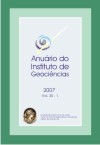Paleoecological considerations on the notoungulates of Tremembé formation, Taubaté Basin (São Paulo State, Brazil)
DOI:
https://doi.org/10.11137/2007_1_77-82Abstract
Notoungulates were recovered from bentonitic clays of the Tremembé Formation (Taubaté Basin). Two families, three genres and two species are known so far: Leontinidae (Taubatherium paulacoutoi and ?Ancylocoelus) and Notohippidae (Rhychippus brasiliensis). Analyzing the paleobiology data of this group and the geological context of the basin together, we assume that leontinids inhabited lake's margin, occupy a niche similar to the capybara (Hydrochoerus), having amphibian habit and feeding on plants like Pteridophyta, Cyperaceae, Typhaceae, aquatic plants and with Gramineae possibilities. Although notohippids seem to forest dwellers, they probably supported selective habits, feeding on fruits, young leaves and buds.Downloads
Download data is not yet available.
Downloads
Published
2007-01-01
How to Cite
Melo, D. J. de, Bergqvist, L. P. and Alvarenga, H. M. F. (2007) “Paleoecological considerations on the notoungulates of Tremembé formation, Taubaté Basin (São Paulo State, Brazil)”, Anuário do Instituto de Geociências. Rio de Janeiro, BR, 30(1), pp. 77–82. doi: 10.11137/2007_1_77-82.
Issue
Section
Article
License
This journal is licensed under a Creative Commons — Attribution 4.0 International — CC BY 4.0, which permits use, distribution and reproduction in any medium, provided the original work is properly cited.















